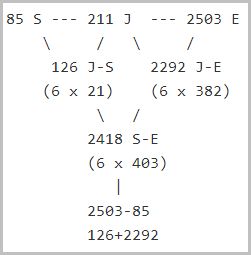
Here we find a match between the orbit numbers of Jupiter, Saturn and Uranus and see what that might tell us about certain patterns in the solar system.
715 U = 60072.044 years
2040 S = 60072.895 years
5064 J = 60072.282 years
Data source: Nasa/JPL – Planets and Pluto: Physical Characteristics
The Jupiter-Saturn part of the chart derives directly from this earlier Talkshop post:
Why Phi? – Jupiter, Saturn and the de Vries cycle
The numbers are simply multiplied by 24 to obtain the match with the Uranus orbits:
2503 E * 24 = 60072y
85 S * 24 = 2040 S
211 J * 24 = 5064 J
126 J-S * 24 = 3024 J-S
So there’s a match between J, S and U but also a few other points:
715 U = 55 * 13 (Fibonacci numbers)
3024 J-S = 144 * 21 (Fibonacci numbers)
2040 S = 34 * 5 * 3 * 2 * 2 (Fibonacci numbers)
24 * 2503y = 25 * 2402.88y
This result corresponds to the long-term solar inertial motion cycle referred to by Charvatova:
Responses of the basic cycles of 178.7 and 2402 yr in solar–terrestrial phenomena during the Holocene
by I. Charvátová and P. Hejda
Pattern Recogn. Phys., 2, 21–26, 2014
This period of 60072 years thus provides another link between the de Vries cycle and solar inertial motion, in addition to: 6 de Vries = 7 Jose cycles.
Note that 3024 J-S (see chart) = 144 * 21, and 21 J-S = 2 de Vries cycles, so 60072y = 288 de Vries according to this model.
– – –
Regarding the Phi aspect:
1 Uranus orbit = 4.2294~ J-S conjunctions
Phi³ = 4.236~ (> 99.84% match)
Dividing the chart numbers by 5:
143 U (13 * 11) = 408 S (34 * 12)
1 U = (13/34 * 11/12) S
13/34 is a Fibonacci equivalent of 1/Phi²
Alternatively, 1 U = 2.8531064 S
2.8531064 * (11/12) = 2.6153475
34/13 = 2.6153846 (> 99.998% match)







Is Uranus in the ‘wrong’ place?
– – –
Did a rogue star change the makeup of our solar system?
July 20, 2018
In recent years, space scientists have begun to suspect that something out of the ordinary happened to our solar system during its early years. Many have begun to wonder why there is not as much material in the outer solar system as logic would suggest. Also, why is Neptune so much more massive than Uranus, which is closer to the sun? And why do so many of the smaller objects in the outer solar system have such oddly shaped orbits? In addressing such questions, many space scientists have begun to wonder if a star might have wandered by during the early years of the solar system—coming just close enough to pull some of the objects in the outer parts of the solar system from their prior positions.
Read more at: http://phys.org/news/2018-07-rogue-star-makeup-solar.html
More information: Outer solar system possibly shaped by a stellar fly-by, arXiv:1807.02960 [astro-ph.GA] arxiv.org/abs/1807.02960
From the abstract: A fly-by also naturally explains the puzzling fact that Neptune has a higher mass than Uranus. Our simulations suggest that many additional Sednoids at high inclinations still await discovery, perhaps including bodies like the postulated planet X.
– – –
Then there’s the ‘Kuiper cliff’.
The Kuiper belt terminates suddenly at a distance of 48 AU from the Sun.
http://en.wikipedia.org/wiki/Planets_beyond_Neptune#Kuiper_cliff
I love arithmetic but why does 0 x 0 = a gravy cube?
Here’s some arithmetic:
If Uranus had one less orbit in the period, there would be exactly 7 Uranus orbits per 20 Saturn orbits.
714 U : 2040 S divided by 102 = 7:20 ratio
Passing star, maybe, but more likely orbital instabilities. Systems with multiple resonances can enter periods where the resonances interfere destructively. Shown well in this simulation from 2:25 on:
Phi differences minimise this.
3024 Jupiter-Saturn conjunctions (see chart above) = 189 * 16 J-S
Rhodes Fairbridge (former Emeritus Professor of Geology at Columbia University in New York) wrote:
An interesting link with planetary cycles exists at a triple ratio figure : 317.749 years (7 Uranus-Saturn laps/ 16 Saturn-Jupiter laps/ 17 lunar declination cycles). A storminess record in geomorphic (that is, physical) form is preserved in a “staircase” of 184 isostatically uplifted beach lines on Hudson Bay (Fairbridge and Hillaire-Marcel” 1977, Nature. Vol. 268), which date back to more than 8,000 years. Their extraordinary regularity is duplicated in other parts of the Arctic, which denies any theory of randomness in storminess cycles. Their mean periodicity is about 45 years, but secondary modulation appears at 111 years, 317 years, and longer intervals. [bold added]
http://www.mitosyfraudes.org/Calen2/Rhodes.html
Re: 7 Uranus-Saturn laps – 189 * 7 = 1323, so the chart has two ‘extra’ (1325)
Likewise Jupiter-Uranus – 189 * 23 = 4347 (chart has 4349, = 1325 + 3024)
[…] In fact two more rows in the table would bring us to 55*13 Uranus orbits, which featured in an earlier blog post: Why Phi? – a long-term Jupiter-Saturn-Uranus model […]